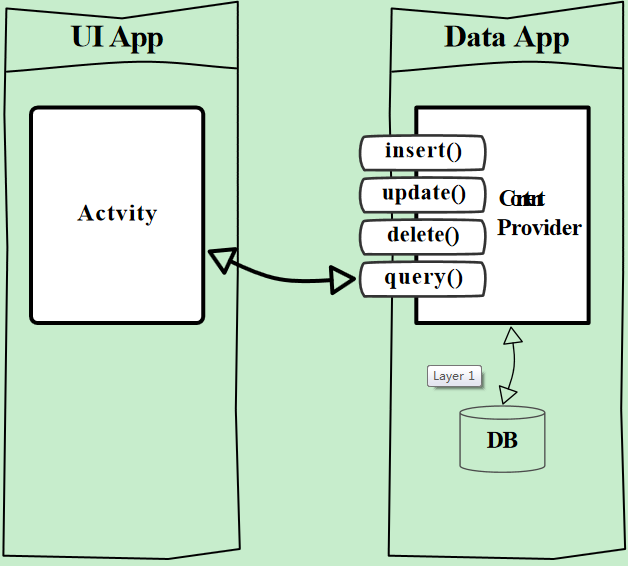标签:android
安卓应用程序默认是无法获取到其他程序的数据,这是安卓安全学的基石(沙盒原理)。但是经常我们需要给其他应用分享数据,内容提供者就是一个这种可以分享数据给其他应用的接口。
可以简单的理解为,内容提供者就是一个可以在不同应用程序间共享数据的组件,相当于一个中间人,一个程序把数据暴露给这个中间人,另一个则通过这个中间人获取相应的数据.
下面的这张图片能更直观的显示:

ContentProvider中的getContext和AndroidTestCast中的getContext方法一样,都是一个模拟的上下文,必须在该类初始化之后才会调用setContext方法将context设置成自己的成员变量中记录,
所以对于获取getContext的时候只能放在方法内,不能放到成员位置,因为在成员上时是null,而在方法内调用时该类就会已经初始化完了
ContentProvider中的query()后不能关闭数据库,因为其他的应用在调用该query方法时需要继续使用该返回值Cursor,所以不能关闭数据库,因为数据库关闭之后Cursor就不能用了,
Cursor中保存的数据其实是数据库的一个引用,如果数据库关了Cursor就不能找到里面的数据了,Cursor.close()只是释放·Cursor·用到的资源。说到这里就多数一句
According to Dianne Hackborn (Android framework engineer) there is no need to close the database in a content provider.以为内容提供者是因为进程启动时便加载,之后就一直存在,当进程销毁
释放资源时会去关闭数据库。
如果数据是SQLiteDatabase,表中必须有一个_id的列,用来表示每条记录的唯一性。
ContentProvider,并实现相应的方法。public class NoteProvider extends ContentProvider {
private static final int NOTES = 1;
private static final int NOTE_ID = 2;
public static final String AUTHORITY = "com.charon.demo.provider.noteprovider";
public static final String TABLE_NAME = "note";
// 定义一个名为`CONTENT_URI`必须为其指定一个唯一的字符串值,最好的方案是以类的全名称
public static final Uri CONTENT_URI = Uri.parse("content://" + AUTHORITY + "/" + TABLE_NAME);
// 声明一个路径的检查者,参数为Uri不匹配时的返回值
// 虽然是中间人,但也不能谁要数据我们都给,所以要检查下,只有符合我们要求的人,我们才会给他数据。
private static UriMatcher sUriMatcher = new UriMatcher(UriMatcher.NO_MATCH);
private NoteSQLiteOpenHelper mSQLiteOpenHelper;
private SQLiteDatabase mSQLiteDatabase;
static {
// 建立匹配规则,例如发现路径为ccom.charon.demo.provider.noteprovider/note/1表示要操作note表中id为1的记录
sUriMatcher.addURI(AUTHORITY, TABLE_NAME, NOTES);
sUriMatcher.addURI(AUTHORITY, TABLE_NAME + "/#", NOTE_ID);
}
/**
* Implement this to initialize your content provider on startup.
* This method is called for all registered content providers on the
* application main thread at application launch time. It must not perform
* lengthy operations, or application startup will be delayed.
* <p/>
* <p>You should defer nontrivial initialization (such as opening,
* upgrading, and scanning databases) until the content provider is used
* (via {@link #query}, {@link #insert}, etc). Deferred initialization
* keeps application startup fast, avoids unnecessary work if the provider
* turns out not to be needed, and stops database errors (such as a full
* disk) from halting application launch.
* <p/>
* <p>If you use SQLite, {@link android.database.sqlite.SQLiteOpenHelper}
* is a helpful utility class that makes it easy to manage databases,
* and will automatically defer opening until first use. If you do use
* SQLiteOpenHelper, make sure to avoid calling
* {@link android.database.sqlite.SQLiteOpenHelper#getReadableDatabase} or
* {@link android.database.sqlite.SQLiteOpenHelper#getWritableDatabase}
* from this method. (Instead, override
* {@link android.database.sqlite.SQLiteOpenHelper#onOpen} to initialize the
* database when it is first opened.)
*
* @return true if the provider was successfully loaded, false otherwise
*/
@Override
public boolean onCreate() {
mSQLiteOpenHelper = new NoteSQLiteOpenHelper(getContext());
return true;
}
/**
* 内容提供者暴露的查询的方法.
*/
@Override
public Cursor query(Uri uri, String[] projection, String selection,
String[] selectionArgs, String sortOrder) {
mSQLiteDatabase = mSQLiteOpenHelper.getReadableDatabase();
Cursor cursor;
// 1.重要的事情 ,检查 uri的路径.
switch (sUriMatcher.match(uri)) {
case NOTES:
break;
case NOTE_ID:
String id = uri.getLastPathSegment();
if (TextUtils.isEmpty(selection)) {
selection = selection + "_id = " + id;
} else {
selection = selection + " and " + "_id = " + id;
}
break;
default:
throw new IllegalArgumentException("UnKnown Uri" + uri);
break;
}
cursor = mSQLiteDatabase.query(TABLE_NAME, projection, selection, selectionArgs, null, null, sortOrder);
if (cursor != null) {
cursor.setNotificationUri(getContext().getContentResolver(), uri);
}
return cursor;
}
/**
* Implement this to handle requests for the MIME type of the data at the
* given URI. The returned MIME type should start with
* <code>vnd.android.cursor.item</code> for a single record,
* or <code>vnd.android.cursor.dir/</code> for multiple items.
* This method can be called from multiple threads, as described in
* <a href="{@docRoot}guide/topics/fundamentals/processes-and-threads.html#Threads">Processes
* and Threads</a>.
* <p/>
* <p>Note that there are no permissions needed for an application to
* access this information; if your content provider requires read and/or
* write permissions, or is not exported, all applications can still call
* this method regardless of their access permissions. This allows them
* to retrieve the MIME type for a URI when dispatching intents.
*
* @param uri the URI to query.
* @return a MIME type string, or {@code null} if there is no type.
*/
@Override
public String getType(Uri uri) {
// 注释说的很清楚了,下面是常用的格式
// 单个记录的IMEI类型 vnd.android.cursor.item/vnd.<yourcompanyname>.<contenttype>
// 多个记录的IMEI类型 vnd.android.cursor.dir/vnd.<yourcompanyname>.<contenttype>
switch (sUriMatcher.match(uri)) {
case NOTE_ID:
// 如果uri为 content://com.charon.demo.noteprovider/note/1
return "vnd.android.cursor.item/vnd.charon.note";
case NOTES:
return "vnd.android.cursor.dir/vnd.charon.note";
default:
return null;
}
// 这个MIME类型的作用是要匹配AndroidManifest.xml文件<activity>标签下<intent-filter>标签的子标签<data>的属性android:mimeType。
// 如果不一致,则会导致对应的Activity无法启动。
}
@Override
public Uri insert(Uri uri, ContentValues values) {
mSQLiteDatabase = mSQLiteOpenHelper.getWritableDatabase();
switch (sUriMatcher.match(uri)) {
case NOTES:
break;
case NOTE_ID:
break;
default:
throw new IllegalArgumentException("UnKnown Uri" + uri);
break;
}
long rowId = mSQLiteDatabase.insert(TABLE_NAME, null, values);
if (rowId > 0) {
Uri noteUri = ContentUris.withAppendedId(CONTENT_URI, rowId);
getContext().getContentResolver().notifyChange(noteUri, null);
return noteUri;
}
return null;
}
@Override
public int delete(Uri uri, String selection, String[] selectionArgs) {
mSQLiteDatabase = mSQLiteOpenHelper.getWritableDatabase();
switch (sUriMatcher.match(uri)) {
case NOTES:
break;
case NOTE_ID:
String id = uri.getLastPathSegment();
if (TextUtils.isEmpty(selection)) {
selection = selection + "_id = " + id;
} else {
selection = selection + " and " + "_id = " + id;
}
break;
default:
throw new IllegalArgumentException("UnKnown Uri" + uri);
break;
}
int count = mSQLiteDatabase.delete(TABLE_NAME, selection, selectionArgs);
getContext().getContentResolver().notifyChange(uri, null);
return count;
}
@Override
public int update(Uri uri, ContentValues values, String selection,
String[] selectionArgs) {
switch (sUriMatcher.match(uri)) {
case NOTES:
break;
case NOTE_ID:
break;
default:
throw new IllegalArgumentException("UnKnown Uri" + uri);
break;
}
mSQLiteDatabase = mSQLiteOpenHelper.getWritableDatabase();
int update = mSQLiteDatabase.update(TABLE_NAME, values, selection, selectionArgs);
return update;
}<provider
android:name="com.charon.demo.provider.NoteProvider"
android:authorities="com.charon.demo.provider.noteprovider" >ContentResolver去操作ContentProvider, ContentResolver用于管理ContentProvider实例,并且可实现找到指定的ContentProvider并获取里面的数据 java
public void query(View view){
//得到内容提供者的解析器 中间人
ContentResolver resolver = getContentResolver();
Cursor cursor = resolver.query(NoteProvider.CONTENT_URI, null, null, null, null);
while(cursor.moveToNext()){
String name = cursor.getString(cursor.getColumnIndex("name"));
int id = cursor.getInt(cursor.getColumnIndex("id"));
float money = cursor.getFloat(cursor.getColumnIndex("money"));
System.out.println("id="+id+",name="+name+",money="+money);
}
cursor.close();
}
public void insert(View view){
ContentResolver resolver = getContentResolver();
ContentValues values = new ContentValues();
values.put("name", "买洗头膏");
values.put("money", 22.58f);
resolver.insert(NoteProvider.CONTENT_URI, values);
}
public void update(View view){
ContentResolver resolver = getContentResolver();
ContentValues values = new ContentValues();
values.put("name", "买洗头膏");
values.put("money", 42.58f);
resolver.update(NoteProvider.CONTENT_URI, values, "name=?", new String[]{"买洗头膏"});
}
public void delete(View view){
ContentResolver resolver = getContentResolver();
resolver.delete(NoteProvider.CONTENT_URI, "name=?", new String[]{"买洗头膏"});
}
内容观察者的原理:
How a content provider actually stores its data under the covers is up to its designer. But all content providers implement a common interface for querying the provider and
returning results — as well as for adding, altering, and deleting data.
It‘s an interface that clients use indirectly, most generally through ContentResolver objects.
You get a ContentResolver by calling getContentResolver() from within the implementation of an Activity or other application component:
You can then use the ContentResolver‘s methods to interact with whatever content providers you‘re interested in.
一方使用内容观察者去观察变化
protected void onCreate(Bundle savedInstanceState) {
super.onCreate(savedInstanceState);
setContentView(R.layout.activity_main);
ContentResolver resolver = getContentResolver();
resolver.registerContentObserver(NoteProvider.CONTENT_URI, true, new NoteObserver(new Handler()));
}
private class NoteObserver extends ContentObserver {
public NoteObserver(Handler handler) {
super(handler);
}
//当观察到数据发生变化的时候 会执行onchange方法.
@Override
public void onChange(boolean selfChange) {
super.onChange(selfChange);
Log.i(TAG,"发现有新的短信产生了...");
//1.利用内容提供者 中间人 获取用户的短信数据.
ContentResolver resolver = getContentResolver();
// .. 重新查询
cursor = ...;
cursor.close();
}
}一方在发生变化的时候去发送改变的消息
对于一些系统的内容提供者内部都实现了该步骤,如果是自己写程序想要暴露就必须要加上该代码。
getContext().getContentResolver().notifyChange(uri, null);标签:android
原文地址:http://blog.csdn.net/charon_chui/article/details/43764117